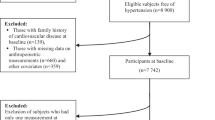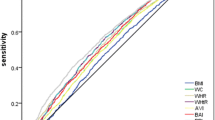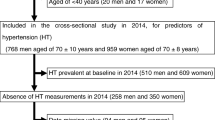Abstract
BACKGROUND: The increased health risks associated with obesity have been found to occur in Asians at lower body mass indices (BMIs). To determine the optimal cut-off values for overweight or obesity in Taiwan, we examined the relationships between four anthropometric indices and cardiovascular risk factors.
METHODS: The data were collected from four health-screening centers from 1998 to 2000 in Taiwan. Included were 55 563 subjects (26 359 men and 29 204 women, mean age=37.3±10.9 and 37.0±11.1 y, respectively). None had known major systemic diseases or were taking medication. Individual body weight, height, waist circumference (WC), and a series of tests related to cardiovascular risk (blood pressure, fasting plasma glucose, triglycerides, total cholesterol, low- and high-density lipoprotein cholesterol) were assessed and their relationships were examined. Receiver operating characteristic (ROC) analysis was used to find out the optimal cut-off values of various anthropometric indices to predict hypertension, diabetes mellitus and dyslipidemia.
RESULTS: Of the four anthropometric indices we studied, waist-to-height ratio (WHtR) in women was found to have the largest areas under the ROC curve (women=0.755, 95% CI 0.748–0.763) relative to at least one risk factor (ie hypertension or diabetes or dyslipidemia). The optimal cut-off values for overweight or obesity from our study in men and women showed that BMIs of 23.6 and 22.1 kg/m2, WCs of 80.5 and 71.5 cm, waist-to-hip ratios (WHpR) of 0.85 and 0.76, and WHtR of 0.48 and 0.45, respectively, may be more appropriate in Taiwan.
CONCLUSIONS: WHtR may be a better indicator for screening overweight- or obesity-related CVD risk factors than the other three indexes (BMI, WC and WHpR) in Taiwan. Our study also supported the hypothesis that the cut-off values using BMI and WC to define obesity should be much lower in Taiwan than in Western countries.


Similar content being viewed by others
References
Kuczmarski RJ, Flegal KM, Campbell SM, Johnson CL . Increasing prevalence of overweight among US adults. The National Health and Nutrition Examination Surveys, 1960 to 1991 JAMA 1994 272: 205–211.
Flegal KM, Carroll MD, Kuczmarski RJ, Johnson CL . Overweight and obesity in the United States: Prevalence and trends, 1960–1994 Int J Obes Relat Metab Disord 1998 22: 39–47.
World Health Organization. Obesity: preventing and managing the global epidemic WHO: Geneva 1998.
Kopelman . Obesity as a medical problem Nature 2000 404: 635–643.
Pi-Sunyer X . Health implications of obesity Am J Clin Nutr 1991 53: 1595s–1603s.
Hubert HB, Feinleib M, McNamara PM, Castelli WP . Obesity as an independent risk factor for cardiovascular disease: a 26-year follow-up of participants in the Framingham Heart Study Circulation 1983 67: 968–977.
William BK, Ralph BD, Janet LC . Effect of weight on cardiovascular disease Am J Clin Nutr 1996 63: 419s–422s.
Seidell JC, Verschu Ren WM, Van Leer EM, Kromhout D . Overweight, underweight, and mortality. A prospective study of 48,187 men and women Arch Intern Med 1996 156: 958–963.
Björntorp P . Metabolic implications of body fat distribution Diabetes Care 1991 14: 1132–1143.
Larsson B, Svardsud K, Welin L, Wilhelmsen L, Bjorntorp P, Tibblin G . Abdominal adipose tissue distribution, obesity, and risk of cardiovascular disease and death: 13 y follow up of participants in the study of men born in 1913 Br Med J 1984 288: 1401–1404.
Kissebah AH, Vydelingum N, Murray R, Evans DJ, Hartz AJ, Kalkhoff RK, Adams PW . Relation of body fat distribution to metabolic complications of obesity J Clin Endocrinol Metab 1982 54: 254–260.
Mazess RB, Barden HS, Bisek JP, Hanson J . Dual-energy X-ray absorptiometry for total body and regional bone mineral and soft tissue composition Am J Clin Nutr 1990 51: 1106–1112.
Lukaski HC . Methods for the assessment of human body composition: Traditional and new Am J Clin Nutr 1987 46: 537–556.
Friedl KE, Deluca JP, Marchitelli LJ, Vogel JA . Reliability of body-fat estimations from a four-compartment model by using density, body water, and bone mineral measurements Am J Clin Nutr 1992 55: 764–770.
Kushner RF, Schoeller DA, Fjeld CR, Danford L . Is the impedance index (H2/R) significant in predicting total body water Am J Clin Nutr 1992 56: 835–839.
Gallagher D, Visser M, Sepulveda D, Pierson RN, Harris T, Heymsfield SB . How useful is body mass index for comparison of body fatness across age, sex, and ethnic groups? Am J Epidemiol 1996 143: 228–239.
Deurenberg P, Yap M, van Staveren WA . Body mass index and percent body fat: a meta-analysis among different ethnic groups Int J Obes Relat Metab Disord 1988 22: 1164–1171.
Pouliot MC, Despres JP, Lemieux S et al. Waist circumference and abdominal sagittal diameter: best simple anthropometric indexes of abdominal visceral adipose tissue accumulation and related cardiovascular risk in men and women Am J Cardiol 1994 73: 460–468.
Després J-P, Prud'homme, Pouliot MC, Trembley A, Bouchard C . Estimation of deep abdominal adipose-tissue accumulation from siimple anthropometric measurements in men Am J Clin Nutr 1991 54: 471–477.
Hsieh SD, Yoshinaga H . Abdominal fat distribution and coronary heart disease risk factors in men—waist/height ratio as a simple and useful predictor Int J Obes Relat Metab Disord 1995 19: 585–589.
Hsieh SD, Yoshinaga H . Waist/height ratio as a simple and useful predictor of coronary heart disease risk factors in women Intern Med 1995 34: 1147–1152.
Ko GTC, Chan JCN, Woo J, Lau E et al. Simple anthropometric indexes and cardiovascular risk factors in Chinese Int J Obes Relat Metab Disord 1997 21: 995–1001.
Wang J, Thornton JC, Russell M, Burastero S, Heymsfield S Jr, Pierson RN . Asians have lower body mass index (BMI) but higher percent body fat than do whites: comparisons of anthropometric measurements Am J Clin Nutr 1994 60: 23–28.
Deurenberg-Yap M, Yian TB, Kai CS, Deurenberg P, van Staveren WA . Manifestation of cardiovascular risk factors at low levels of body mass index and waist-to-hip ratio in Singaporean Chinese Asia Pacific J Clin Nutr 1999 8: 177–183.
Hsieh SD, Yo Shinaga H, Muto T, Sakurai Y, Kosaka K . Health risks among Japanese men with moderate body mass index Int J Obes Relat Metab Disord 2000 24: 358–362.
Wang J, Russell-Aulet M, Mazariegos M et al. Body fat by dual photon absorptiometry (DPA): comparisons with traditional methods in Asians, Blacks and Caucasians Am J Hum Biol 1992 4: 501–510.
World Health Organization. The Asia-Pacific perspective: redefining obesity and its treatment WHO: Geneva 2000.
Department of Health. Taiwan Public Health Report 1998–2000 DOH: Taipei 1998–2000.
van der Schouw YT, Verbeek ALM, Ruijs JHJ . ROC curves for the initial assessment of new diagnostic tests Fam Pract 1992 9: 506–511.
Metz CE . Basic principles of ROC analysis Sem Nucl Med 1978 8: 283–298.
Swets JA . The relative operating characteristics in psychology Science 1973 182: 990–1000.
Hanley JA, McNeil BJ . The meaning and use of the area under a receiver operating characteristic (ROC) curve Radiology 1982 143: 29–36.
World Health Organization. Obesity: preventing and managing the global epidemic eport of a WHO Consultation of Obesity, 3–5 June WHO: Geneva 1997.
Rissanen P, Hamalainen P, Vanninen E, Tenhunen-Eskelinen M, Uusitupa M . Relationship of metabolic variables to abdominal adiposity measures by different anthropometric measurements and dual-energy X-ray absorptiometry in obese middle-aged women Int J Obes Relat Metab Disord 1997 21: 367–371.
Hodge AM, Dowse GK, Gareeboo H, Tuomilehto J, Alberti KGMM . Incidence, increasing prevalence, and predictors of change in obesity and fat distribution over 5 years in the rapidly developing population of Mauritus Int J Obes Relat Metab Disord 1996 20: 137–146.
Ko GTC, Chan JCN, Cockram CS, Woo J . Prediction of hypertension, diabetes or albuminuria using simple anthropometric indexes in Hong Kong Chinese Int J Obes Relat Metab Disord 1999 23: 1136–1142.
Han TS, van Leer EM, Seidell JC, Lean MEJ . Waist circumference action levels in the identification of cardiovascular risk factors: prevalence study in a random sample Br Med J 1995 311: 1401–1405.
Lean MEJ, Han TS, Morrison CE . Waist circumference as a measure for indicating need for weight management Br Med J 1995 311: 158–161.
Kopelman . Obesity as a medical problem Nature 2000 404: 635–643.
Pi-Sunyer X . Health implications of obesity Am J Clin Nutr 1991 53: 1595s–1603s.
Reeder BA, Angel A, Ledoux M, Rabkin SW, Young TK, Sweet LE . Obesity and its relation to cardiovascular disease risk factors in Canadian adults Can Med Assoc J 1992 146: 2009–2019.
Kim SM, Lee DJ . What is the best simple anthropometric indexes of abdominal visceral fat in obese patients? J Korean Soc Study Obes 1998 7: 157–168.
Author information
Authors and Affiliations
Corresponding author
Rights and permissions
About this article
Cite this article
Lin, WY., Lee, LT., Chen, CY. et al. Optimal cut-off values for obesity: using simple anthropometric indices to predict cardiovascular risk factors in Taiwan. Int J Obes 26, 1232–1238 (2002). https://doi.org/10.1038/sj.ijo.0802040
Received:
Revised:
Accepted:
Published:
Issue Date:
DOI: https://doi.org/10.1038/sj.ijo.0802040
- Springer Nature Limited
Keywords
This article is cited by
-
Comparison of cardiovascular disease risk in women with and without breast cancer: secondary data analysis with the 2014–2018 korean national health and nutrition examination survey
BMC Public Health (2023)
-
Prevalence of Overweight and Obese Prepregnancy BMI and Excessive Gestational Weight Gain Using Asian-Specific Cutoffs Among Asian and Mixed-Asian Women Living in Hawaii: A Retrospective Cohort Study
Maternal and Child Health Journal (2023)
-
Cardiovascular health and four epigenetic clocks
Clinical Epigenetics (2022)
-
Ethnic Specific body fat percent prediction equation as surrogate marker of obesity in Ethiopian adults
Journal of Health, Population and Nutrition (2021)
-
Optimal cutoff values for anthropometric indices of obesity as discriminators of metabolic abnormalities in Korea: results from a Health Examinees study
BMC Public Health (2021)




